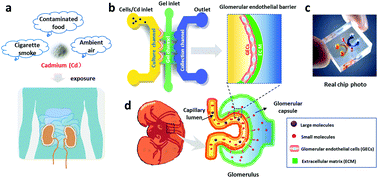Assessment of cadmium-induced nephrotoxicity using a kidney-on-a-chip device
Abstract
Cadmium (Cd) is a common environmental pollutant. Its effects on human health have attracted great attention. The kidney is the organ that is the most affected by Cd exposure. Thus, it is highly desirable to develop a reliable model to evaluate Cd-induced nephrotoxicity in vitro. We present a kidney-on-a-chip with three compartmentalized culture chambers to examine Cd-induced nephrotoxicity. The culture and collection channels represent the capillary and the glomerular capsule sides of the glomerular filtration barrier, respectively. Isolated primary rat glomerular endothelial cells (GECs) were cultured on the side surface of the middle gel channel. The integrated GEC layer demonstrated the selective permeability of the renal barrier. Therefore, it was further utilized to study the nephrotoxicity induced by Cd exposure at different concentrations. Cd induced significant cytotoxicity and disrupted the expression of tight junction protein ZO-1 in a dose-dependent manner. Moreover, Cd exposure increased the permeability of the endothelial layer to large molecules, immunoglobulin G and albumin. These results facilitate the understanding of the underlying mechanism of kidney dysfunction and glomerular disease. This is the first study on Cd-induced nephrotoxicity using primary GECs in a microfluidic device. The kidney-on-a-chip device enables direct visualization and quantitative analysis of GEC responses to Cd in real time. It may provide a micro-scale platform based on the human system for nephrotoxicity testing under varying environmental exposure.



 Please wait while we load your content...
Please wait while we load your content...